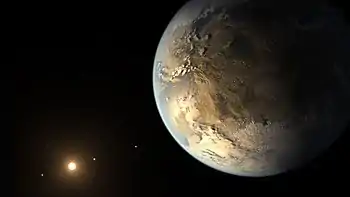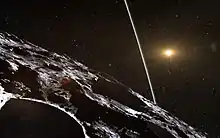C/2013 V5 (Oukaimeden)
C/2013 V5 (Oukaimeden) is a retrograde Oort cloud comet discovered on 12 November 2013 by Oukaimeden Observatory at an apparent magnitude of 19.4 using a 0.5-meter (20 in) reflecting telescope.[1]
| Discovery | |
|---|---|
| Discovered by | Oukaimeden Observatory 0.5-m reflector (J43)[1] |
| Discovery date | 12 November 2013 |
| Orbital characteristics A | |
| Epoch | 20 September 2014[2] |
| Orbit type | Oort cloud |
| Aphelion | ~370000 AU (inbound)[lower-alpha 1] ~680 AU (outbound) |
| Perihelion | 0.62539 AU (q)[2] |
| Eccentricity | 0.99868[2] |
| Orbital period | several million years inbound (Barycentric solution for epoch 1950)[3] ~6000 years outbound (Barycentric solution for epoch 2050)[3] |
| Inclination | 154.88°[2] |
| Last perihelion | 28 September 2014[2] |
From 5 May 2014 until 18 July 2014 it had an elongation less than 30 degrees from the Sun.[4] By late August 2014 it had brighten to apparent magnitude 8[5] making it a small telescope and high-end binoculars target for experienced observers. It crossed the celestial equator on 30 August 2014 becoming a southern hemisphere object.[4] On 16 September 2014 the comet passed 0.480 AU (71,800,000 km; 44,600,000 mi) from Earth.[6] The comet peaked around magnitude 6.2 in mid-September 2014[7][8] but only had an elongation of about 35 degrees from the Sun.[4] On 20 September 2014 the comet was visible in STEREO HI-1B.[9] The comet came to perihelion (closest approach to the Sun) on 28 September 2014 at a distance of 0.625 AU (93,500,000 km; 58,100,000 mi) from the Sun.[2]
C/2013 V5 is dynamically new. It came from the Oort cloud with a loosely bound chaotic orbit that was easily perturbed by galactic tides and passing stars. Before entering the planetary region (epoch 1950), C/2013 V5 had an orbital period of several million years.[3] After leaving the planetary region (epoch 2050), it will have an orbital period of about 6000 years.[3]
Notes
- The listed distance for the inbound AU is very close to a "no solution" Hyperbolic trajectory. The JPL Horizons answer of 370,000 AU (6 ly) is not realistic because it is just a generic fit to a curve assuming that the Sun+Comet are the only two objects in the universe.
References
- "MPEC 2013-V95 : COMET C/2013 V5 (OUKAIMEDEN)". IAU Minor Planet Center. 15 November 2013. Retrieved 5 May 2013. (CK13V050)
- "MPEC 2014-J58: Observations and Orbits of Comets". IAU Minor Planet Center. 12 May 2014. Retrieved 15 June 2014.
- Horizons output. "Barycentric Osculating Orbital Elements for Comet C/2013 V5 (Oukaimeden)". Retrieved 15 June 2014. (Solution using the Solar System Barycenter and barycentric coordinates. Select Ephemeris Type:Elements and Center:@0)
- "Elements and Ephemeris for C/2013 V5 (Oukaimeden)". IAU Minor Planet Center. Archived from the original on 17 May 2014. Retrieved 15 June 2014.
- Yoshida, Seiichi (31 August 2014). "Weekly Information about Bright Comets (2014 Aug. 23: South)". aerith.net. Retrieved 21 October 2014.
- "JPL Close-Approach Data: C/2013 V5 (Oukaimeden)" (last observation: 2014-04-13; arc: 152 days). Retrieved 15 June 2014.
- Yoshida, Seiichi (20 September 2014). "Weekly Information about Bright Comets (2014 Sept. 20: South)". aerith.net. Retrieved 21 October 2014.
- Seiichi Yoshida (11 May 2014). "C/2013 V5 ( Oukaimeden )". Seiichi Yoshida's Comet Catalog. Retrieved 15 June 2013.
- Karl Battams (22 September 2014). "Comet C/2013 V5 Oukaimeden is in the @NASA STEREO HI-1B images". Retrieved 23 September 2014.
External links
- Activity level and perihelion distance (Bortle survival limit Jakub Cerny 11 August 2014)
- C/2013 V5 Oukaimeden wide-field (Damian Peach 31 August 2014)
- C/2013 V5 map for Aug 21 – Sept 5
- Did we catch disintegration of comet Oukaimeden? (FRAM)
- (C/2013 V5 magnitude)




